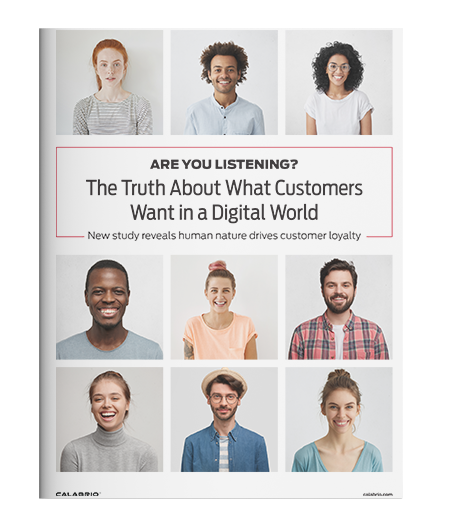To stay on top of the business ladder, it is imperative for companies to tap into new technology innovations that can help improve the customer experience journey. But more than just taking advantage of emerging technologies to enhance organizational performance, what companies should do is to build trust and foster stronger and lasting relationships with their customers by keeping customer connection at the heart of their strategy.
For knowledge-centric companies, it means understanding how customers think, feel, and behave, and using this crucial information to create meaningful interactions and relevant experiences. By creating an emotional connection with customers, companies can meet their wants, needs, and emotions; thus, building customer trust and earning their loyalty in the process.
SourceForge recently caught up with Richard McElroy, the General Manager of the Innovation Center at Calabrio, to discuss the findings of their latest study on how human nature drives customer loyalty in today’s digital-oriented world. McElroy also offers insights on how organizations can seamlessly navigate the ever-changing customer service landscape and shares how Calabrio ONE helps businesses achieve efficiency in customer care and improve overall customer satisfaction.
Q: In June, Calabrio released a very insightful report entitled, “Are You Listening? The Truth About What Customers Want in a Digital World.” Before anything else, what motivated you to perform this study?

Richard McElroy, the General Manager of the Innovation Center at Calabrio
A: At Calabrio, we work with contact centers all over the world. And, in the last 10 years alone, we have seen a drastic change in the way companies interact with customers. Using the phone is not the only option; customers can now take advantage of any number of self-service options.
This shift in customer behavior requires companies to take inventory of current processes and understand how new technologies are impacting the customer experience. This survey was aimed to unlock insights about what motivates customers throughout the customer experience journey and help guide our customers as they navigate the new reality of customer service.
Q: What was the most surprising finding from the study?
A: It wasn’t surprising—at least to us—that customers still want a great product or service at a competitive price and that humans are the key differentiator in the customer experience. What was shocking is how much of a difference people can make when it comes to customer satisfaction and loyalty. Even in a digital world, the customer experience must cater to how customers think, feel and act—and how they feel is a big part of their decision making. And humans have the power to build those emotional connections in a way that technology can’t.
Consider this: 74 percent of customers say they are more loyal to a brand if they can speak to someone, 60 percent feel that their voices are being heard when they can speak to a live person and 43 percent would consider switching to a competitor if there was no option to speak with a human being. Those numbers don’t lie. Customers want to communicate with humans and agents in the contact center can make or break that interaction. To win the hearts––and emotions––of customers, companies must strike the right balance between the convenience of technology and the personalization of the human touch.
Q: What do you think are the best ways to measure customer loyalty?
A: Measuring customer loyalty is more complex than simply looking at retention or churn rates. Loyalty is really about having an emotional connection with a brand or product that keeps a customer coming back—even if a competitor is offering something similar. While things like surveys can help, to really understand loyalty, companies need to look at customer behavior and sentiment across channels. By recording calls and analyzing interactions with speech analytics, businesses can extract more than what customers say—they can understand how they feel.
Tools such as Calabrio Sentiment Analysis, which assign a positive, negative or neutral score to each interaction and can detect things like negation and other verbal indicators, let companies know what customers really think, how loyal they actually are and how loyal they might be in the future.
Q: Chatbots and other automated solutions have no doubt made it easier for companies to handle an influx of inbound queries. But organizations cannot rely on technology alone, and that’s due to human nature. How can businesses strike a balance between innovating using new technology, such as artificial intelligence (AI), and creating authentic customer connections?
A: Technology creates opportunities, and customers and employees agree: 41 percent of agents say new technology means that they’ll have fewer mundane tasks, and 76 percent of customers think that technology helps create a good customer experience. But there’s a catch: Just under half said that they don’t care about new technology unless they understand how it benefits their own experience.
 However, to be successful, companies must find that balance between humans and technology, which means understanding their own journey and what their customers want. For example, technology is great for handling lower-level, easier inquiries because it frees up human employees to manage the more in-depth requests. Although just because technology can help doesn’t mean it should be difficult for a customer to switch gears and get in touch with a human representative, if needed. The study revealed that 35 percent of customers would actually be critical of a business if it was too difficult to speak with someone.
However, to be successful, companies must find that balance between humans and technology, which means understanding their own journey and what their customers want. For example, technology is great for handling lower-level, easier inquiries because it frees up human employees to manage the more in-depth requests. Although just because technology can help doesn’t mean it should be difficult for a customer to switch gears and get in touch with a human representative, if needed. The study revealed that 35 percent of customers would actually be critical of a business if it was too difficult to speak with someone.
All roads in the customer experience must lead to humans, and if companies design a journey that makes it difficult to reach representatives, they’ll lose potentially loyal consumers along the way.
Q: Before deploying any new technology that has the potential to boost the customer experience, what factors should organizations consider?
A: There are three things to consider before moving forward with any new technology: the company’s existing tech stack, what experiences customers want and whether existing employees are being set up for success. By performing an audit of the current technology being used, companies can look at original goals versus where the business is now and make any necessary changes to take a people-first approach.
Using analytics, companies can tap into the interactions agents are having with customers to discover how satisfied customers are with each experience. And finally, setting their agents up for success by putting the right training in place and emphasizing their role in creating a great customer experience, ensures they’re empowering employees to build connections with customers.
Q: Can you name some examples of businesses that excel at humanizing their brand while tapping the power of AI and other new technologies at the same time? What can other brands learn from them?
A: Mastercard is a good example of leveraging artificial intelligence technology to benefit customers. Customers can use Facebook messenger to check on specific transactions or account balances, and the company even recently launched an AI platform to help detect and manage fraud. Yet the company still makes it easy for customers to pick up the phone and reach a representative and, on their website, they invite customers to tweet them directly. They’ve done a great job of using modern technology to help customers get quick answers about their accounts while making their employees available when customers need them most.
Q: What role does Calabrio play in helping organizations innovate while driving customer loyalty?
 A: Calabrio gives companies the tools they need to hear the voice of the customer across all channels. This allows them to make informed decisions about their customer experience strategies. We also know how important contact center agents are to that experience. The Calabrio ONE platform is designed to equip those professionals with insights to identify areas where training is needed, offer relevant feedback to cement best practices and empower them to deliver on customer expectations. And all the customer insights coming into the business can be analyzed and reported on to help businesses drive strategic decisions.
A: Calabrio gives companies the tools they need to hear the voice of the customer across all channels. This allows them to make informed decisions about their customer experience strategies. We also know how important contact center agents are to that experience. The Calabrio ONE platform is designed to equip those professionals with insights to identify areas where training is needed, offer relevant feedback to cement best practices and empower them to deliver on customer expectations. And all the customer insights coming into the business can be analyzed and reported on to help businesses drive strategic decisions.
At the core, we are a customer engagement analytics software company, and we are constantly innovating to give our customers access to new tools such as AI, machine learning and analytics so they can give their customers the experience they want.
Q: And any other insights you can share!
A: As new communication methods have emerged, we’ve seen companies adding channels—such as web, chat, email, text, and more—so quickly that they’re not laying the proper groundwork. In fact, we recently released another report titled, The Danger of Digital, which revealed some critical deficiencies in companies’ omnichannel strategies.
While it’s true customers want to communicate in new and different ways, organizations should design strategies that allow them to glean cross-channel insights so they can determine what customers really want, create an experience that maps to the customer journey, and train and equip agents to manage these new methods. Otherwise, companies risk alienating customers due to under-supported options.
About Calabrio
Calabrio is a leading provider of customer engagement and analytics software with 400 employees and more than 4,500 customers worldwide. Established in 2007, this Minnesota-based customer engagement software company empowers organizations across the world by delivering cutting-edge and easy-to-use tools that support better customer experiences. Calabrio specializes in customer interaction, call center, Voice over Internet Protocol (VoIP), call recording, speech analytics, workforce optimization, and more.
